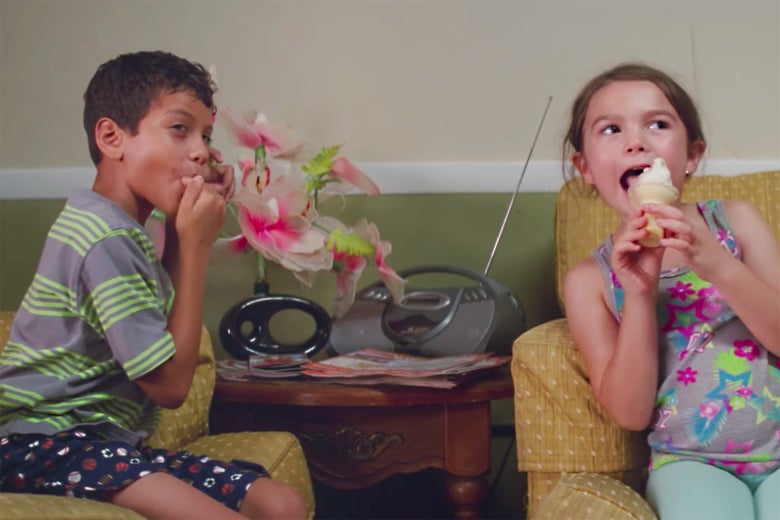
Along Route 192 in South Florida, on the way to the Disney tourist mecca of Orlando, lie a string of less glamorous businesses, each serving in its way the Disney economy of high-capitalist pleasure: discount gift shops, stores selling oranges out of buildings shaped like actual oranges, a big-box store called Machine Gun America. This fantastical landscape also features pastel-painted budget hotels with names that make unwise promises: Arabian Nights, Futureland, the Enchanted Inn, the Magic Castle.
That last is the setting for Sean Baker’s third film, The Florida Project, which follows a pair of families living week-to-week inside the Magic Castle’s lilac-painted stucco walls. Though they’re perpetually one paycheck away from homelessness, young single mothers Halley (Bria Vinaite) and Ashley (Mela Murder) don’t lead grim, joyless lives. In fact, their children Moonee (Brooklynn Prince) and Scooty (Christopher Rivera) are as buoyantly happy as only little kids on summer vacation can be. They treat the purple palace as their own playground: swimming in the pool, spying on the guests, and tormenting the establishment’s long-suffering manager, Bobby (Willem Dafoe), with pranks like sneaking into the utility room to cut off the whole building’s power. Roaming the exurban environs with a little girl from a neighboring hotel (Valeria Cotto), they sometimes court bigger trouble, like when they set fire to a pillow in an abandoned house or use a neighbor’s car hood for spitting practice.
Baker has acknowledged Hal Roach’s Our Gang series, with its pack of Depression-era mischief-makers, as a key influence. (Both Roach and George “Spanky” McFarland are thanked in the very last credit.) But Baker’s little rascals inhabit a seedier and more perilous milieu than their cinematic predecessors. Though The Florida Project is a wonderful film about childhood, with one of the finest child performances in years from the then–6-year-old Floridian Prince, it isn’t at all for kids.
In fact, during filming, the director shielded the child actors from some of the movie’s more adult content. Like the characters they play, they’re not always aware of the implications of what’s going on around them, but the viewer is all too clear on the precariousness of the kids’ summer idyll.
Halley, a profanity-spouting chain-smoker who’s had past run-ins with the law, toes the line between rebellious free spirit and dangerously negligent parent. She makes her rent, barely, by selling wholesale perfume at a markup to passing tourists. For food, she sneaks Moonee into the breakfast buffets at nicer hotels or sends the kids to cadge waffles at the back door of the diner where Ashley works. Every so often, the two mothers share a blunt in the pool or head out together for a night at the club. It’s a bare-bones but tenable existence—until something shifts in Halley’s circumstances and the specter of real homelessness begins to loom large.
Though The Florida Project—named after Walt Disney’s working name for Disneyworld in its early planning stages—has a sun-drenched, Starburst-hued atmosphere all its own, its down-and-out Florida location and child’s-eye view of poverty sometimes recall Barry Jenkins’ Moonlight, another film that was more poetic and lovingly composed than its hardscrabble setting would seem to require. Baker doesn’t romanticize the difficulty of his characters’ life on the fringes, but he doesn’t systematically miserable-ize it either. Even in tough circumstances, the ebullient Moonee and her pals regularly experience—and create—moments of beauty, joy, and laughter. There are rainbows, fireworks displays, and spontaneous armpit-fart contests. Dafoe’s patient, dry-humored Bobby keeps a keen eye out for the Magic Castle residents’ welfare, at one point chasing a potential pedophile away from the kids’ play area with extreme prejudice. But he’s also aware of the limits of his ability to protect them while continuing to run a safe hotel (and hold on to his own job).
The film’s structure at first seems loose and episodic, with repeated scenes of the kids tromping through marshy fields and strip-mall parking lots looking for trouble. But each scene, even the seemingly improvised ones consisting only of short bursts of overlapping dialogue, serves a purpose, establishing a plot point or observing a key moment in the characters’ relationships. The widescreen 35-millimeter cinematography by Alexis Zabe (Silent Light) bathes even the dullest freeway intersections in a serene magic-hour glow. (In an era when dark circumstances tend to be filmed in dark colors, this is a meditation on post–financial-crash poverty served in blazing tones of fuchsia and teal.) You can always sense the presence of Disneyworld just offscreen, its prohibitive expensiveness beating down like the sun. One highway sign Moonee and her increasingly stressed-out mother keep passing directs the driver to “Seven Dwarfs Lane.”
The Florida Project’s ambiguous ending is its boldest stylistic gesture, and not every viewer will enjoy the sense of dislocation it creates. A sudden shift from 35mm to handheld iPhone—the medium in which Baker shot his 2015 micro-masterpiece, Tangerine—is accompanied by the movie’s first and only burst of non-diegetic music. The events that unfold after this change are mysterious: They might “really” be happening or they might be taking place in the young protagonist’s imagination. (Though no previous dream sequence has established a grammar for any such place. Until that moment, The Florida Project has been naturalistic to the point that the dialogue is sometimes inaudible.) I’m not sure I can explain this last sequence, but after two viewings, thinking about it still gives me a thrill. Maybe the ending’s power lies in its willingness to abandon meaning and transport the viewer to one of those spaces where the real and the imaginary seamlessly, if temporarily, overlap. A little like the movies, or childhood.